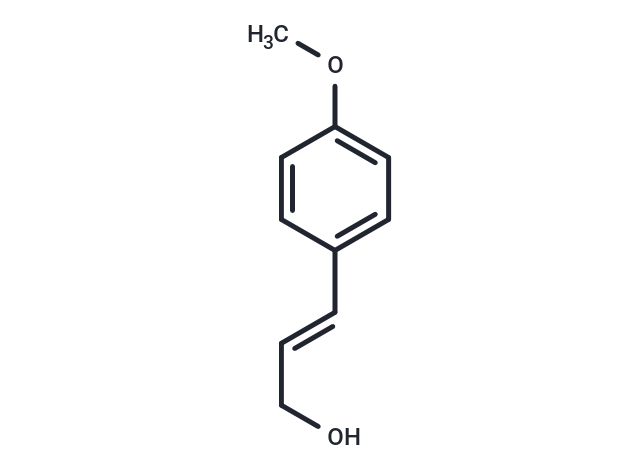Shopping Cart
- Remove All
 Your shopping cart is currently empty
Your shopping cart is currently empty

4-Methoxycinnamyl alcohol showed toxicity to MCF-7, HeLa and DU145 cancer cell lines with IC50 values of 14.24, 7.82 and 22.10 μg/mL, respectively. 4-Methoxycinnamyl alcohol was isolated from Foeniculum vulgare. 4-Methoxycinnamyl alcohol did not show apoptotic effects but showed necrosis after 48 h in a 10 μg/mL DNA fragmentation study.

| Pack Size | Price | Availability | Quantity |
|---|---|---|---|
| 1 mg | $196 | In Stock | |
| 5 mg | $498 | In Stock | |
| 10 mg | $725 | In Stock | |
| 25 mg | $1,130 | In Stock | |
| 50 mg | $1,520 | In Stock | |
| 1 mL x 10 mM (in DMSO) | $598 | In Stock |
| Description | 4-Methoxycinnamyl alcohol showed toxicity to MCF-7, HeLa and DU145 cancer cell lines with IC50 values of 14.24, 7.82 and 22.10 μg/mL, respectively. 4-Methoxycinnamyl alcohol was isolated from Foeniculum vulgare. 4-Methoxycinnamyl alcohol did not show apoptotic effects but showed necrosis after 48 h in a 10 μg/mL DNA fragmentation study. |
| Targets&IC50 | MCF-7 cell lines:14.24 μg/mL, DU145 cell lines:22.10 μg/mL, HeLa cells:7.82 μg/mL |
| In vitro | In the present study, anti-inflammatory effect of hexane, ethyl acetate, and water fractions of rhizomal ethanol extracts of E. pavieana was evaluated for their inhibition on NO production and mechanism in LPS-stimulated macrophages. Inhibitory activities on NO production were performed in LPS-stimulated RAW264.7 macrophage. Cytotoxicity of plant extracts was measured by 3-(4,5-dimethylthiazol-2-yl)-2,5-diphenyltetrazolium bromide assay, mRNA and protein expressions by reverse transcription-polymerase chain reaction and Western blotting analysis, respectively. Ethyl acetate fraction of E. pavieana (EPE) showed the most potent inhibitory effect on NO production in macrophages. EPE significantly decreased NO production and inhibited inducible nitric oxide synthase (iNOS) protein and mRNA expression in a dose-dependent manner. Furthermore, the level of nuclear factor-kappa B p65 subunit was markedly reduced in activated cells treated with EPE. Four phenolic compounds, 4-Methoxycinnamyl alcohol (1), trans-4-methoxycinnamaldehyde (2), 4-methoxycinnamyl p-coumarate (3), and p-coumaric acid (4), were obtained from bioactivity-guided isolation technique. CONCLUSIONS: The anti-inflammatory property contained in E. pavieana rhizome extract and conferred through inhibition of iNOS expression, and NO formation provides scientific evidence and support for the development of new anti-inflammatory agents based on extracts from this plant.[1] |
| Molecular Weight | 164.2 |
| Formula | C10H12O2 |
| Cas No. | 53484-50-7 |
| Smiles | COC1=CC=C(\C=C\CO)C=C1 |
| Relative Density. | 1.31g/cm3 |
| Storage | store at low temperature | Powder: -20°C for 3 years | In solvent: -80°C for 1 year | Shipping with blue ice. |

Copyright © 2015-2025 TargetMol Chemicals Inc. All Rights Reserved.